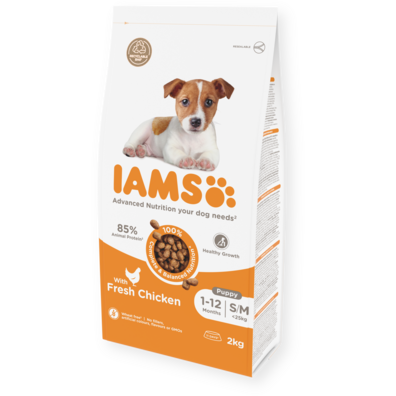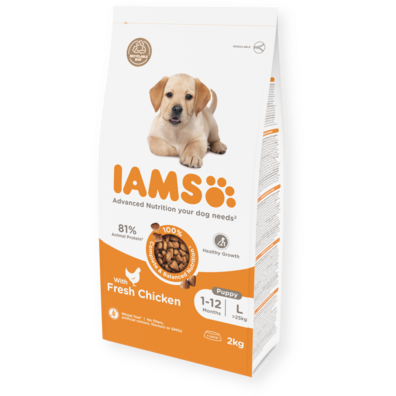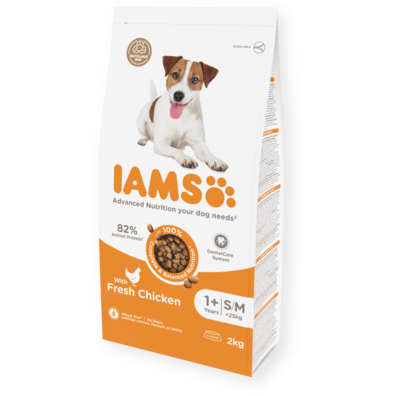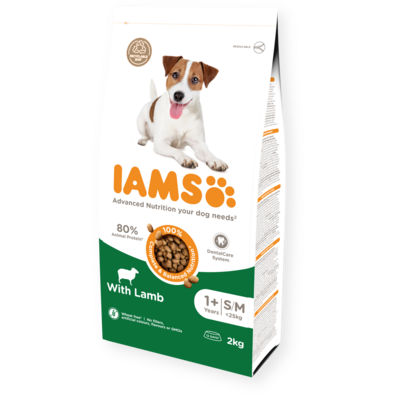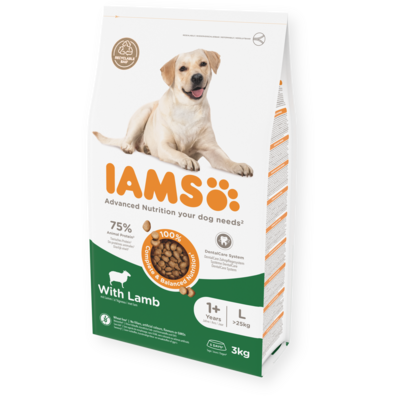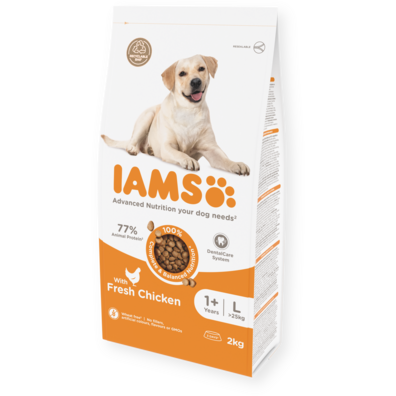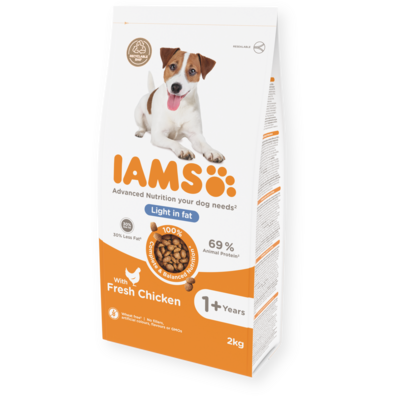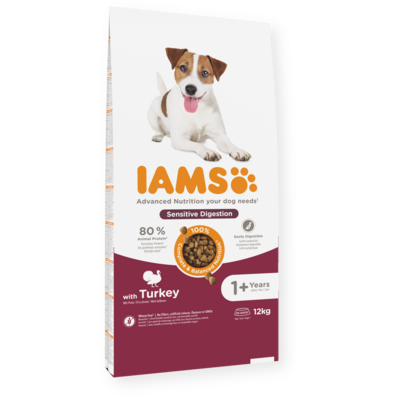Feeding a growing puppy
The ultimate puppy feeding guide
Puppies grow at an incredible rate, with some breeds reaching their adult weight as early as 6 months, while humans need around 18 years to get there! During this rapid stage, the right puppy feeding routine is essential to support healthy growth, play, and learning. Choosing the right dog food for puppies will give your pup the energy and nutrients they need to thrive now and build a healthy foundation for the future.

Why proper puppy nutrition is essential
The first year of a dog’s life is all about rapid growth. Bones, muscles and the immune system develop faster than at any other time, which makes nutrition the key to a strong start. A feeding guide ensures your pup gets the right mix of protein, vitamins and minerals to support this growth. Feeding the right amount at the right times helps avoid underfeeding or overfeeding, setting your puppy up for long-term health and happiness.
The seven signs of puppy vitality
At IAMS, we’re pet owners too and we know that puppies need more than just calories. They need nutrition that supports every aspect of their growth and well-being. That’s why our recipes are created to match the unique needs of young dogs. Just as children’s needs change as they grow, so do puppies’, and the right puppy feeding plan helps them thrive at every stage.
The Seven Signs of Puppy Vitality are:
- Healthy Growth: High-quality animal protein and essential minerals for steady development.
- Strong Bones: Enriched with minerals and vitamin D to support bone strength and confidence.
- Healthy Teeth: Crunchy kibbles and essential minerals to help protect against early dental issues.
- Healthy Digestion: A tailored fibre blend, including prebiotics and beet pulp, for a balanced tummy.
- Healthy Immune System: Antioxidants and E to strengthen natural defences.
- Healthy Skin and Shiny Coat: Omega-3 and omega-6 fatty acids for skin nourishment and a glossy coat.
- Healthy Brain Development: DHA for cognitive growth and easier trainability.
How much and how often to feed your puppy
Puppy feeding schedule
Every puppy is unique: Their breed, age and energy levels all play a role in how much food they need. Following a puppy feeding plan helps to make sure your pup gets the right amount at the right time without overfeeding or underfeeding. For owners asking, “how often to feed a puppy?”, the answer depends on their age: younger puppies usually need three to four meals a day, while older pups can gradually move to two meals.
Following puppy feeding chart provides general guidance for the specific IAMS puppy food you are feeding. Your puppy’s daily portions may vary based on age, activity, and growth— and because each IAMS puppy formula is different, always check the feeding chart on your bag for the most accurate guidance.
How much to feed a puppy chart (by weight and age)
IAMS Puppy Small/Medium Breed Dry Food Chicken:
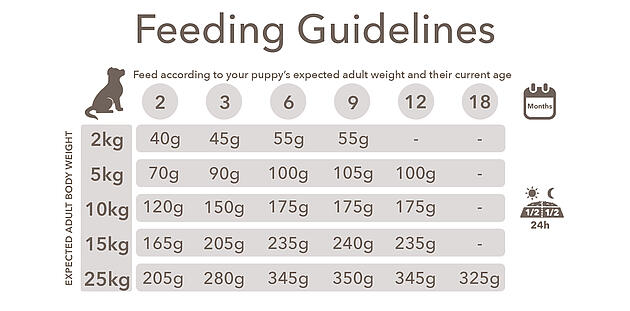
IAMS Puppy Large Breed Dry Food Chicken:
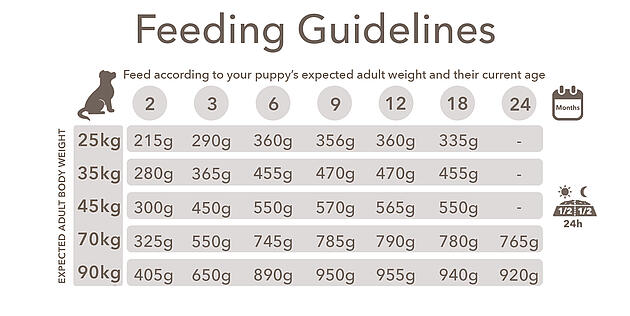
Understanding your puppy’s energy needs
In the first few months, puppies burn a lot of energy as they grow, explore, and play, so their feeding amounts are higher during this stage in relation to their weight. Around 6 months, growth begins to slow, and portion sizes are adjusted to match their lower energy needs and support a healthy growth rate. Neutering can also influence metabolism, making it even more important to monitor feeding closely, although not relevant for most dogs in their growing phase.
Many owners ask, “How do I know if I’m feeding my puppy enough?” The best way to tell is by keeping an eye on your puppy’s body condition and energy levels, while following a growth curve based on their expected adult body weight. This helps ensure they’re getting the right amount of food for healthy, steady growth.
Charts and a puppy feeding calculator can be great tools, but every dog is different — adjust portions if your pup is gaining too much or too little weight.
Transitioning to adult dog food
Most puppies are ready to switch to adult dog food around 12 months of age, though the exact timing depends on breed and size. Smaller breeds may transition earlier, while larger breeds often take a bit longer.
To make the change smooth:
- Start gradually: Mix a small amount of adult food into your puppy’s meals.
- Increase slowly: Over 7–10 days, gradually increase the adult food portion while decreasing puppy food.
- Monitor closely: Watch your puppy’s weight, energy, and digestion to ensure they adjust well.
- Adjust meal frequency: Most puppies can move to 2 meals a day during this transition, which helps regulate energy levels and digestion.
Tips for creating a puppy feeding plan
Every puppy is unique, so a successful puppy feeding plan should be tailored to their breed, activity level and overall health. Some puppies burn more energy, while others grow more slowly, so portion sizes and feeding frequency may need adjustment.
Regularly tracking your puppy’s weight and meal portions helps you spot changes early and keep them on a healthy growth path. Using a puppy feeding schedule puppy feeding chart can make this process easier, ensuring your puppy gets the right nutrition at every stage of growth.
FAQ
Puppies can drink their mother’s milk or a specially formulated puppy milk replacer in their first few weeks of life, which provides the nutrients they need to grow. However, cow’s milk or regular dairy is not recommended for puppies, as it can cause stomach upset, diarrhea, and nutrient imbalances. Once they’re weaned, puppies should get a complete and balanced puppy food, with water as their main liquid.
Your puppy should always be fed a dedicated, complete, and balanced puppy food. Any “human foods” should only be given occasionally as a small treat. Safe options include cooked lean meats, plain rice, cooked vegetables, and some fruits like apple or banana. Always avoid chocolate, grapes, onions, garlic, avocado, nuts, and caffeine, as these can be toxic to dogs.
Most puppies can move from 2-3 meals to 2 meals a day around 6–12 months, depending on their breed and activity. Reduce meals gradually while monitoring appetite and energy.


